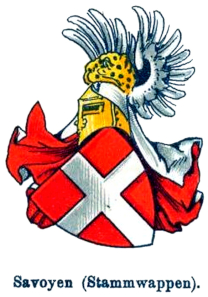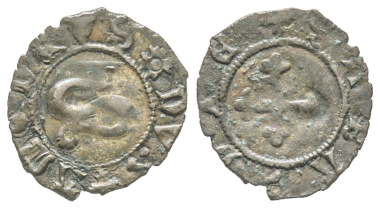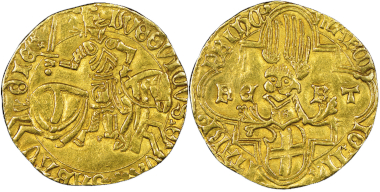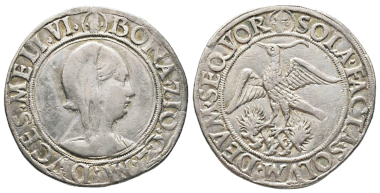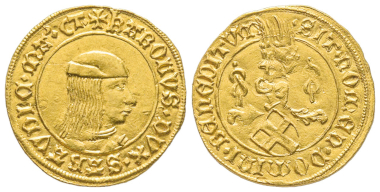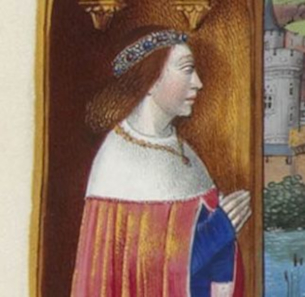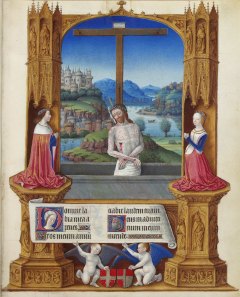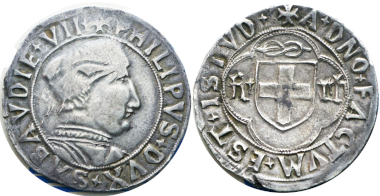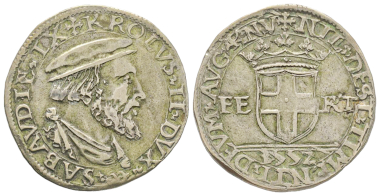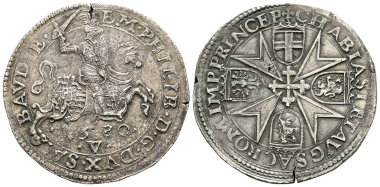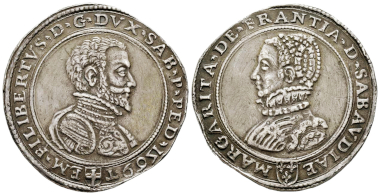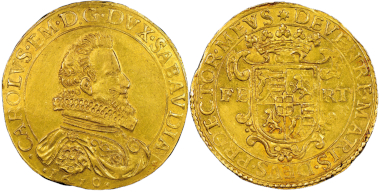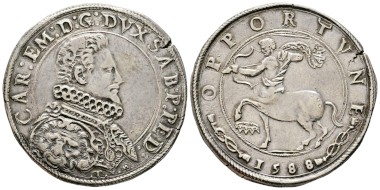On November 17, 2018, the Monaco-based Auction house Éditions Victor GADOURY will auction off an extensive collection of coins and medals of the Casa Savoia originating from the possessions of a gentleman of the royal family. Could we get a better opportunity than this to remember why and when the counts of Savoy rose from a small noble family to the kings of Italy? We will tell you the story and illustrate it with coins of the collection.
The Coat of Arms of the Dukes of Savoy.
Chapter 1: The Rise to European Importance
One thing is true for the entire period of the Middle Ages: advancement is easiest when it is not sure that the man at the top will be able to stay at the top. And the House of Savoy owes its origins to exactly this situation.
The Ottonian king Heinrich II (1014-1024) passed away childless. His successor Konrad II (1024-1039) introduced the rule of the Salians. His rise to the top was supported by an insignificant feudal lord called Umberto Biancamano. In return, he received a fief which encompassed three important Alpine passes: the Mont Cenis, the Great and the Little St Bernhard. This meant his descendants had won the lottery. Because whoever controlled the Alpine passes controlled the connection between Italy and the Empire. And all kings wanted to go to Italy to be crowned emperor in Rome.
The counts of Savoy were thus endowed with territories and rewarded with titles whenever powerful men were dependent on them again. How much this helped them gain importance is best understood when one looks at whom their daughters were married to. Among the sons-in-law were two emperors, one from Germany and one from Byzantium, a German anti-king, two kings from France, one king from Portugal and Naples respectively, and a large number of members of Southern-German and Italian major nobility, whether they may have been Habsburgs or Luxembourgers, Visconti, Sforza, or Medici.
Amedeo VIII., 1391-1434. Bianchetto. MIR 149 (R8). Extremely rare. Extremely fine. Estimate: 600 euros. From Gadoury Auction (November 17, 2018), no. 1448.
A Savoyard as the last antipope
On November 1, 1391, Amedeo VII, whose neat sobriquet was “The Red Count”, fell off his horse. It was a fatal fall. Thus, his son Amedeo VIII became his successor at the tender age of eight already.
His reign was more than successful. In 1416, King Sigismund made him duke. In 1418, he inherited the title of Lord of Piedmont. He had his son marry Anne de Lusignan. She brought along 100,000 Venetian ducats and 10,000 écu. That was quite a large amount of money! What was even better in the eyes of pious counts were her family relationships: the House of Lusignan constituted the non-reigning kings of Jerusalem! Even though it had of course long been conquered at the time.
Ludovico, 1439-1465. Ducato d’oro, Cornavin. MIR 155b (R3). NGC AU53. Estimate: 4,000 euros. From Gadoury Auction (November 17, 2018), no. 1449.
In 1434, Amedeo had had enough of politics. Just as Karl V later did, he resigned from his official duties to meditate at a Lake Geneva monastery. While his son Ludovico took over reigns, Amedeo VIII led a life which at the time was considered saintly. He built up such a good reputation that in 1439 the Council of Basel elected him pope during a council which only lasted a couple hours. Amadeus accepted but resigned in 1449 already to ensure the Church’s unity. He made history as the last Catholic antipope.
Bona di Savoia, 1476-1481. Testone, Milano, Gian Galeazzo Maria Sforza. MIR 218/1 (R3). Very rare. Very fine+. Estimate: 5,000 euros From Gadoury Auction (November 17, 2018), no. 1457.
His son Ludovico acted rather unluckily. But his wife bore 19 children who he could employ for his political purposes: one good example is Bonne, born in 1449, who is better known as Bona di Savoia. First, she was promised to the English King Edward IV. When the marriage was broken off, she married Galeazzo Maria Sforza. She gained numismatic importance when her husband was murdered at the age of 32. His seven-year-old son took over the title, Bona took over the reigns. She was then chased off by the murdered king’s brother: Ludovico Maria Sforza, commonly known as “Il Moro”.
Carlo I., 1482-1490. Ducato d’oro, II tipo, Torino. MIR 223a var. (D/MA) (R9). Unedited and probably unique. Extremely fine. Estimate: 50,000 euros. From Gadoury Auction (November 17, 2018), no. 1460.
Chapter 2: Between France and Burgundy
At a time when primogeniture was not yet the norm, a large number of sons always signified a weakening for the domain as the later-born sons had to be provided with territories too. One particular problem was that the oldest son, called Amedeo IX, of all people developed epilepsy. His oldest son was only four years old when Amedeo resigned. His second-oldest son Carlo, who took over reigns after his oldest brother passed away in 1482, was only 13-years-old. Although he would not play an important role in history he at least did so in art history.
left: Obverse of the previous coin. right: Segment from Jean Colombe, Très Riches Heures du duc de Berry. Ms65, f. 75f.
His coins are the first ones depicting a portrait of the ruler of Savoy. We encounter a young man with long well-kempt hair wearing a bonnet on his head. The reverse shows the coat of arms of the House of Savoy. A white cross on a red background.
Jean Colombe, Très Riches Heures du duc de Berry. Ms65, f. 75f.
This coat of arms identifies the depicted ruler in one of the most famous paintings of the late Middle Ages. Carlo owned the Duke of Berry’s book of hours. While we would nowadays make do with an “Ex Libris” sticker, Carlo had himself and his wife Bianca of Montferrat depicted on a page in the book.
Carlo I, Carlo II, we really do not have to remember all of these names because Carlo I ruled for only six years – he died shortly before his 22nd birthday; his son and successor – a child of not even two years – fell out of his bed and broke his neck in 1496. Thus, the entire line of Casa Savoia tracing back to Amedeo was extinct and the third son of Ludovico I (yes, exactly, the one with 19 children) took over reigns: Filippo II, who was already 58 years old at the time.
Filippo II, 1496-1497. Testone, I Tipo. MIR 277d (R8). Very fine+ / Extremely fine. Estimate: 20,000 euros. From Gadoury Auction (November 17, 2018), no. 1465.
He was actually supposed to become Duke of Bresse. But unfortunately, precisely this Duchy of Bresse was lost during a conflict between Burgundy and France. That is how Filippo obtained the surname “The Landless”, even though he tried his best to refute this name.
As a young man already, he initiated a revolt against his father. He failed. Which is why the French King Louis XI held him captive at the castles of Loches for two years by order of the Duke of Savoy. It does not surprise that, afterwards, Filippo II preferably sided with the great adversary of France, the Burgundian duke Charles the Bold.
Even though Charles lost the war, Filippo won. His entire family line was destined to constitute the dukes of Savoy. Filippo could not celebrate this achievement for too long. He died on November 7, 1497.
Chapter 3: Between France and Spain
Filiberto II succeeded his father Filippo II in 1497. In the year of his accession to power, the 16-year-old married his nine-year-old cousin Iolanda, heiress to the Kingdom of Cyprus and Jerusalem. From then on, these titles were connected to the Casa Savoia and were gladly used in the inscriptions of coins.
Iolanda died at the age of twelve. Filiberto then married the only legitimate daughter of the later emperor Maximilian I: Margarete. A hunting accident made 24-year-old Margarete a widow and allowed for Filiberto’s younger brother, Carlo III, to come into power.
Carlo III, 1504-1553. Testone, VI Tipo, Aosta. Almost extremely fine. Estimate: 25,000 euros. From Gadoury Auction (November 17, 2018), no. 1469.
The man who erased Savoy from the map
Filiberto had sought association with the Habsburg dynasty because he needed allies in the fight against France. The French King Louis XII had conquered the Duchy of Milan in 1499 and the entire territory of Savoy was consequently surrounded by France. That was quite an inconvenient situation seeing as it was a time when all powerful men were attempting to enlarge their territories. Carlo maneuvered, negotiated, pursued a seesaw policy by alternately joining forces with the French king and the German emperor. But all this maneuvering did not help. The respective war parties alternated in invading and plundering his domain. Large parts of Savoy found themselves under the rule of France, others decided to join the Swiss Confederation.
Geneva, which had traditionally been particularly closely connected to the House of Savoy, had to deal with large financial losses. Geneva depended on international trade. But nobody wanted to use a market that could not guarantee a safe arrival and departure. Therefore, Geneva also broke with the House of Savoy, Charles had to escape and spent the rest of his life more or less in exile.
Emanuele Filiberto, 1553-1580. Tallero, Vercelli, 1580. MIR 505 (R10). Extremely rare. Obverse cleaned slightly, otherwise extremely fine. Estimate: 10,000 euros. From Gadoury Auction (November 17, 2018), no. 1483.
The man who put Savoy back on the map
After his death, his only surviving son Emanuele Filiberto took over the duchy. Or rather what remained of it. Which is why Emanuele Filiberto sided with the Spanish emperor Charles V and his son Philipp II. As general, he commanded big parts of the troops during the siege of Ingolstadt (1546) and the Battle of Mühlberg (1547) which was decisive for the outcome of the war. He was made commander of the imperial troops in Flanders and took over the office of governor of the Habsburg Netherlands in 1556. In 1557, he achieved a great victory over the French king during the Battle of Saint-Quentin. They say more French aristocrats were killed during this battle than during the much more well-known defeat at Azincourt in 1415. We know that this victory was of such great importance for Philipp II of Spain that he decided to build a monastery in honor of St Laurence. The battle had been won on his feast day. This monastery is known today as El Escorial.
In other words, Emanuel Filiberto had ensured a seat at the negotiation table of the Great Powers. That is how he became one of the great profiteers of the Peace of Cateau-Cambrésis that ended the Italian Wars. The French king restored his duchy, but Geneva remained part of the Swiss Confederation.
Emanuele Filiberto, 1553-1580. Scudo da 3 Lire, Turin, 1569, with Margherita di Francia. MIR 565 (R10). Extremely rare. Slightly cleaned field, otherwise extremely fine. Estimate: 50,000 euros. From Gadoury Auction (November 17, 2018), no. 1504.
Emanuele Filiberto then went to reorganize his duchy. The alignment to France was given up in favor of Italy, the capital was moved from Chambéry to Turin. Italian became the official language. Emanuele Filiberto promoted agriculture and small manufactures and thus turned his duchy into a prospering territory which was able to finance his small army of the most well-trained soldiers. Savoy also had its own navy. Its vessels fought in the Battle of Lepanto on the Spanish side. The decisive role the House of Savoy would play on the European stage in the future was mainly based on its impressive army.
Before he passed away, Emanuele Filiberto had put Savoy back on the map. And his oldest son Carlo Emanuele, who was the nephew of the French King Francis I on his mother Margarethe’s side, could not have asked for better conditions to commence a rapid advancement …
Carlo Emanuele, 1580-1630. 10 Scudi d’oro, II Tipo, Turin, 1610. MIR 568 (R10). Only three known specimens. NGC MS60. Estimate: 200,000 euros. From Gadoury Auction (November 17, 2018), no. 1505.
The man who lost it all again
In theory, Carlo Emanuele found the best conditions possible to realize his ambitions. His connections were impeccable: after all, he had married the youngest daughter of the Spanish King Philipp II.
But just as his father-in-law attempted to convert the Dutch to the one true religion, Carlo Emanuele too got carried away trying to put the Calvinists of Geneva under his control. On December 21, 1602, he sent an army of 2000 to 3000 men to the city walls of Geneva. Some of them were supposed to climb the walls and open the gates from the inside under the veil of night – winter solstice is the darkest night of year. But due to the alertness of the people of Geneva, this surprise attack failed, which is a fact that is celebrated to this day by the smashing of the chocolate pot. It is meant to remind people that a simple woman allegedly defeated the attackers by pouring a bowl of hot soup over their heads.
Carlo Emanuele, 1580-1630. Ducatone, II Tipo, Turin, 1588. MIR 600b (R6). Very rare. Finest specimen known. Almost extremely fine. Estimate: 12,000 euros. From Gadoury Auction (November 17, 2018), no. 1511.
At the beginning of the Thirty Years’ War, Carlo Emanuele acted just as unluckily. He kept switching allies until cardinal Richelieu ran out of patience and had French troops invade Savoy. What had been arduously won by the father was lost then by the son. At the time of his death in 1630, Carlo Emanuele could only leave the title his oldest son and successor Vittorio Amadeo.
By the way, the grandson of his youngest son is known as Prince Eugene of Savoy. He was taken into the service of the emperor and went down in history as the most successful commander of his time.
In part 2, the Casa Savoia will ascend the throne but nevertheless lose all their independence temporarily.
In CoinsWeekly you can also read a comprehensive Auction Preview.




